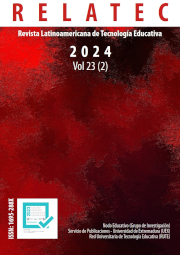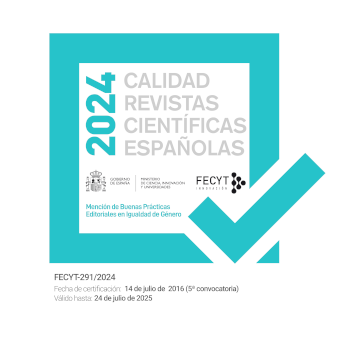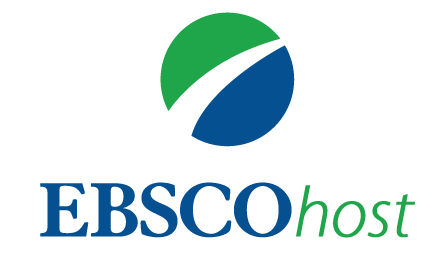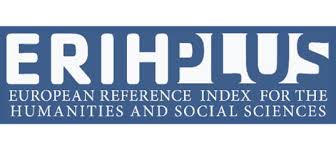Marco DEIFDC: Evaluación del despliegue de la Educación Digital en Perú en plena pandemia de Covid-19
DOI:
https://doi.org/10.17398/1695-288X.23.2.89Palabras clave:
digital education, developing countries, digital economy, social impactResumen
La Educación Digital es un factor clave para que los países en vías de desarrollo puedan competir bajo las nuevas reglas de la Economía Digital. La crisis de la pandemia Covid-19 ha hecho más evidente la necesidad de implementar una estrategia educativa global donde todos los niños puedan estar preparados para aprender en un entorno digital independientemente de su país y condición de nacimiento. En esta investigación se ha definido y aplicado un Índice de Educación Digital para Países en Desarrollo (DEIFDC) para el caso peruano. La construcción del índice se basa en variables relevantes organizadas en tres palancas para determinar la capacidad del Perú para preparar mejor a los actuales niños de primaria para adquirir las competencias necesarias en una fuerza laboral del siglo XXI. Los resultados muestran un buen desarrollo en las capacidades pedagógicas y la preparación de los estudiantes, pero sólo una madurez adecuada en el desarrollo de la infraestructura de las escuelas. El lento desarrollo digital de Perú, en comparación con otros países de la región, está poniendo en peligro la disponibilidad de mano de obra altamente cualificada, el crecimiento del PIB digital y la productividad de los servicios digitales, por lo que será necesario realizar grandes esfuerzos para garantizar que los peruanos se conviertan en una sociedad preparada para el mundo digital.
Descargas
Referencias
Balarín, M. (2013). Las políticas TIC en los sistemas educativos de América Latina. Caso Perú. Unicef. Buenos Aires, Argentina.
Beblavý, M., Baiocco, S., Kilhoffer, Z. Akgüç, M., Jacquot, M. (2019). Index of Readiness for Digital Lifelong Learning. Centre for European Policy Studies with Google. Brussels, Belgium.
BBVA (2020). Digitalización: ¿Qué se ha hecho en Perú y cuáles son los retos a futuro?. BBVA Research. Madrid, Spain.
BBVA (2017). Peru: Advances in digitisation. BBVA Research. Madrid, Spain.
Brynjolfsson, E., Collis A. (2019). How should we measure the Digital Economy?. Harvard Business Review. Boston MA, United States of America.
Cardim, J., Molina-Millán, T., & Vicente, P. C. (2021). Can technology improve the classroom experience in primary education? An African experiment on a worldwide program (No. wp2101). Universidade Nova de Lisboa, Faculdade de Economia, NOVAFRICA.
Cuenca, R. (2020). Educared, 2021: expectativas e incertidumbres. Fundación Telefónica. Li-ma, Perú.
Cristiá, J. P., Ibarraran, P., Cueto, S., Santiago, A., Severin, E. (2012). Technology and child de-velopment: Evidence from the One Laptop per Child program. Inter- American Develop-ment Bank IDB working paper series No. IDB-WP-304.
Department of Economic and Social Affairs (2017). Indigenous Peoples and the 2030 Agenda. United Nations. New York, United States of America.
Dingel, J. I., Neiman, B. (2020). NBER (National Bureau of Economic Research) Working Paper 26948. Cambridge MA, United States of America.
Figueroa, A. (2008). Education, Labour Markets and Inequality in Peru, CRISE (Centre for Re-search on Inequality, Human Security and Ethnicity) Working Paper No. 48, Department of International Development, University of Oxford. Oxford, UK.
Foley, P., Sutton, D., Wiseman, I., Green, L., Moore, J. (2018). International Digital Economy and Society Index, Tech4i2 for the European Commission. Brussels, Belgium.
Freitas, S., Liarokapis F. (2011). Serious Games: A New Paradigm for Education? Serious Games and Edutainment Applications. ISBN 978-1-4471-2160-2 pp 9-23.
Fundación Santillana (2020). Perú: perspectivas y desafíos para la escuela que viene en 8 cla-ves.
Ganimian, A.J., Vegas, E. and Hess, F. M. (2020). Realising the promise: How can education technology improve learning for all? Brookings Institution. Washington, DC. United States of America.
Gianini, S., Bogdan-Martin, D. (2020). UNESCO’s Mobile Learning Week 2020, Beyond Dis-ruption: Technology Enabled Learning Future. Opening Ceremony. Paris, France.
Heckman, J.J. (2007). The economics, technology and neuroscience of human capability for-mation, NBRE (National Bureau of Economic Research) Working Paper 13195. Cambridge MA, United States of America.
Instituto Nacional de Estadística e Informática (2019). Población que accede a Internet. Lima, Perú.
International Telecommunication Union (ITU), (2013). Technology, broadband and education: advancing the education for all agenda. Paris, France.
Internet Society, (2017). Internet Access and Education: Key considerations for policymak-ers. Reston VA, United States of America.
Kalolo, J.F. (2018). Digital revolution and its impact on education systems in developing countries. Educ Inf Technol 24, 345–358.
Kask, M., Feller, N. (2021). “Digital Education in Europe and the EU’s role in upgrading it. Pol-icy Brief. Hertie School. Jacques Delors Centre. Berlin, Germany.
Lieberman, J. I. (2004). Offshore outsourcing and America’s competitive edge: losing out in the high technology and R&D services sectors. Washington DC, United States of America.
Light, D. (2015). Technology, Teaching and Learning. Center for Children and Technology, Ed-ucation Development Center. New York, United States of America.
Linares, J. (2016). Papert el primer ciudadano de la Era Digital dice adiós. Article published in El Peruano. Lima, Perú.
López-Calva, L. F. (2020). Working in times of pandemic: only one in five workers in LAC can actually work from home. UNDP Latin America and the Caribbean. New York, NY. United States of America.
Lopez, O.S. (2010). The Digital Learning Classroom: Improving English Language Learners’ academic success in mathematics and reading using interactive whiteboard technology. Computers & Education, 54(4), 901-915.
Luckin, R., Bligh B., Manches, A, Ainsworth S., Crook C. (2012). Decoding learning: The proof, promise and potential of digital education. Nesta. London, United Kingdom.
Luckin, R., Holmes, W., Griffiths, M., Forcier, L. B. (2016). Intelligence Unleashed: An argu-ment for AI in Education. Pearson Education. London, United Kingdom.
Marcone Flores, S., Castro M., Kanashiro A., Núñez X.M., León, M.G. (2010). Perspectivas de desarrollo de las TIC en el Perú, con especial incidencia en la educación. Ed. Santillana y Consejo Nacional de Educación. Lima, Perú.
Marcone, S. (2004). Proyecto Huascarán: educación pública, tecnología y política. Tecnología y Sociedad. Revista Latinoamericana (ITDG). Nuevas tecnologías: ¿Qué nos espera a los países en desarrollo?. Lima, Perú.
Ministerio de Educación del Estado Plurinacional de Bolivia (2016). Uso de herramientas de autor a través de la pizarra digital interactiva en la concreción curricular. Educa Innova 2016. La Paz, Bolivia.
Ministerio de Educación de la República del Perú (2003). Ley General de Educación, 28044. Lima, Perú.
Ministerio de Educación de la República del Perú (2013). Documento Nacional de las Lenguas originarias del Perú. Lima, Perú.
Ministerio de Educación de la República del Perú (2016). Currículo Nacional de la Educación Básica. Lima, Perú.
Ministerio de Educación de la República del Perú (2020). Resolución Ministerial N° 160-2020-MINEDU. Lima, Perú.
Ministerio de Educación de la República del Perú (2020). Minedu inicia en Cajamarca la dis-tribución de más de un millón de tablets. Lima, Perú.
Ministerio de Educación de la República del Perú (2021). PISA. Oficina de Medición de la Cali-dad. Lima, Perú.
Ministerio de Economía y Finanzas de la República del Perú (2020). Marco Macroeconómico Multianual 2021-2024. Lima, Perú.
Ministerio de Educación de la República del Perú (2020). En octubre se iniciará distribución de tablets a estudiantes y docentes. Lima, Perú.
Panagiotis, K., Punie Y., Devine, Y. (2015). Promoting Effective Digital-Age Learning: A Euro-pean Framework for Digitally-Competent
Educational Organisations”. Brussels, Belgium.
Papert, S. (1993). The children’s machine: Rethinking school in the age of the computer. New York, United States of America.
Petrie, C., García-Millán, C., Mateo-Berganza, M. M. (2021). 21st Century Skills in Latin America and the Caribbean. Inter-American Development Bank. Washington DC, United States of America.
Spotlight: 21st Century Skills in Latin America and the Caribbean HundrED Research. https://hundred.org/en/research
Psacharopoulos, G., Patrinos, H. A. (2018). Returns to Investment in Education: A Decennial Review of the Global Literature. Policy Research Working Paper; No. 8402. World Bank, Washington DC, USA.
Rivielllo, R. (2020). La competencia digital y su desarrollo frente a la nueva realidad. enlightED Conference. Madrid, Spain.
Rivoir, A. (2016). Revisión comparativa de iniciativas nacionales de aprendizaje móvil en América Latina: El caso de la Política TIC en Perú. UNESCO. Buenos Aires, Argentina.
Robin B. R. (2016). The Power of Digital Storytelling to Support Teaching and Learning. Digi-tal Education Review, (30), 17-29.
Ruhl, J. (2015). Teaching Methods for Inspiring the Students of the Future. TEDxLafayette. Video. TEDx Talks, May, 27.
Salas-Pilco, S. Z., Cheung, L., Fang, L., Jiang, L. (2014). ICT in Peruvian education: An overview of its development. Research Studies in Education (Vol. 12, pp. 92-101). Hong Kong, China.
Santiago, A., Severin, E., Cristia, J., Ibarrarán, P., Thompson, J., & Cueto, S. (2010). Experi-mental assessment of the program “One Laptop per Child” in Peru. Inter-American Devel-opment Bank Education. New York, USA.
Scheuer, O., Loll, F., Pinkwart N., McLaren, B.M. (2010). Computer-supported argumentation: A review of the state of the art. International Journal of Computer-Supported Collaborative Learning.
Sethi, A., Suman, V. (2020). Digital resonance: the new factor influencing location attractive-ness. The 2019 Kearney Global Services Location Index. A.T. Kearny. New York, United States of America.
Semáforo Escuela (2020). Resultados 2020. Ministerio de Educación de Perú. Lima, Perú.
Solar Energy International (2018). Developing World Programs. Paonia CO, USA.
Trucano, M. (2010). Worst practice in ICT use in education. World Bank Blogs.
UNESCO (2015). Rethinking Education. Towards a global common good?. Paris, France.
UNESCO (2019). Recommendation on Open Educational Resources (OER). Paris, France.
UNESCO (2020). La Unesco en Perú ante la emergencia del Covid-19. Una respuesta estratégi-ca. Lima, Perú.
UNESCO (2020). World Inequality Database on Education. Paris, France.
UNESCO, Global Education Monitoring Report (2020). COVID-19 is a serious threat to aid to education recovery. Policy Paper, 41. Paris, France.
Unicef and International Telecommunication Union (2020). How many children and young people have internet access at home?
Estimating digital connectivity during the COVID-19 pandemic. New York, United States of America.
United Nations (1948). The Universal Declaration of Human Rights. United Nations General Assembly. Paris, France.
United Nations General Assembly (2015). Transforming our world: the 2030 Agenda for Sus-tainable Development. A/RES/70/1. New York, United States of America.
United Nations Development Program (2019). Informe sobre Desarrollo Humano 2019. Más allá del ingreso, más allá de los promedios, más allá del presente. Desigualdades del desarro-llo humano en el siglo XXI. New York, USA.
Wilson-Body, P. (2020). Unlocking skills for the future.
World Bank (2016). World Development Report 2016: Digital Dividends. Washington DC, USA.
World Bank Group (2017). Peru - Systematic Country Diagnostic. Washington, DC, USA.
World Bank (2019). Ending Learning Poverty: What Will It Take?. Washington DC, USA. https://openknowledge.worldbank.org/handle/10986/32553
World Bank, (2020). Education Context. Washington DC, USA.
World Economic Forum (2020), Jobs of Tomorrow: Mapping Opportunity in the New Economy. Geneva, Switzerland.
Yinghui, S., Zongkai Y., Harrison H. Y., Sanya L., (2012). The impact of interactive white-boards in on education. Wuhan, China. New York, USA.
Descargas
Publicado
Número
Sección
Licencia
Derechos de autor 2024 Ana Victoria Delgado-Martín, José Marí Larrú-Ramos

Esta obra está bajo una licencia internacional Creative Commons Atribución-NoComercial-SinDerivadas 4.0.
Los autores/as que publiquen en esta revista aceptan las siguientes condiciones:
1. Los autores/as conservan los derechos de autor y ceden a la revista el derecho de la primera publicación, con el trabajo registrado con la licencia Creative Commons Reconocimiento-NoComercial-SinObraDerivada 4.0 International (CC BY-NC-ND), que permite a terceros utilizar lo publicado siempre que mencionen la autoría del trabajo y a la primera publicación en esta revista.
2. Los autores/as pueden realizar otros acuerdos contractuales independientes y adicionales para la distribución no exclusiva de la versión del artículo publicado en esta revista (p. ej., incluirlo en un repositorio institucional o publicarlo en un libro) siempre que indiquen claramente que el trabajo se publicó por primera vez en esta revista.
3. Se permite y recomienda a los autores/as a publicar su trabajo en Internet (por ejemplo en páginas institucionales o personales) antes y durante el proceso de revisión y publicación, ya que puede conducir a intercambios productivos y a una mayor y más rápida difusión del trabajo publicado (vea The Effect of Open Access).









